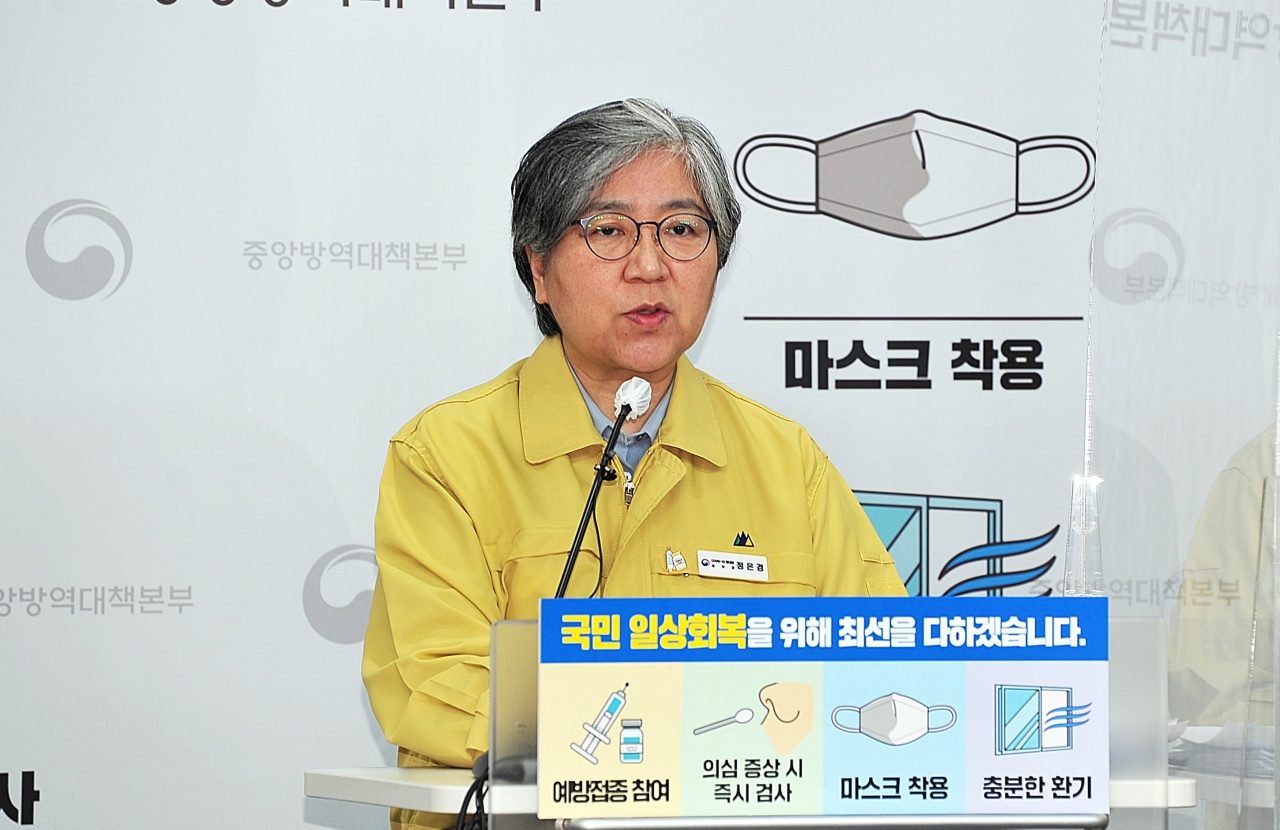
Jeong Eun-kyeong, the Korea Disease Control and Prevention Agency chief, speaks during a televised briefing Monday at the agency headquarters in Osong, North Chungcheong Province. (KDCA)
The head of Korea’s disease control agency said Monday that the state of the COVID-19 outbreak here has gone from “low risk” to “high risk” over the last three weeks as the country began its phased return to normal.
Korea Disease Control and Prevention Agency Commissioner Jeong Eun-kyeong told a televised briefing that “intensive care beds at Seoul hospitals were nearly full to the brink,” with other metrics worsening all across the country.
In response to press inquiries, she said that Korea “may decide whether to bring back some of the lifted restrictions” next week, as the first of the three-phase return to normal comes to an end. But she said that for the time being, subjecting only Seoul -- the epicenter of the country’s outbreak -- to intensive social distancing once again was not being considered internally.
By Sunday at midnight, 907 COVID-19 patients around the country were unable to be admitted to a hospital for more than a day, and 137 of them had waited four days or longer, according to statistics provided by the Ministry of Health and Welfare. On the day prior, 804 patients were waiting for an available bed. At least six have died while waiting on a bed.
After setting a new high of 522 on Nov. 17, the number of patients with severe or critical COVID-19 has been hovering around 500, which is the initially estimated threshold for keeping hospitals running without being overburdened.
The seven-day average of daily deaths climbed to 26 from the previous week’s 19. The case fatality rate so far this month stood at 0.84 percent, which is more than double the rate seen in June of 0.35 percent, before the fourth wave hit and the delta variant took hold.
The administration’s COVID-19 response team has said that as Korea abandons its suppression strategy, trends of hospital admissions and deaths, rather than incidences of new infections, will be the barometer in gauging the severity of the pandemic here.
Son Young-rae, spokesperson for the Health Ministry, told reporters in a closed-door briefing, also held Monday, that demand for hospital care was “growing more rapidly than previously anticipated.” In announcing the Nov. 1 return to normal, the ministry had said the health care system could handle around 5,000 cases being found each day.
He said steps were being taken to cut the length of hospital stays of COVID-19 patients and to maximize turnover of beds. Hospitals will be asked to assess the “appropriateness of hospitalization” for their intensive care patients, he said, and either bump some of them down to “stepdown” beds providing less acute care or discharge them to recover from home.
Another senior ministry official, Park Hyang, said in the same briefing that the success of Korea’s plan to exit pandemic measures “depended on a robust home treatment scheme.”
“To be able to return to normal, the single most critical factor is to allow more patients to be cared for at home,” Park said.
During Wednesday’s press briefing, the ministry and Seoul municipal officials had said a lack of bed availability may force a wider range of patients to stay home to recover, instead of under treatment at medical institutions. Now that comprises mostly patients under 70 years old with mild or no symptoms at the time of diagnosis.
On the other hand, restrictions placed on businesses would be eased to a greater extent. Son said talks were underway to exempt indoor gyms from requiring visitors to submit proof of vaccination or a negative PCR test result.
Speaking with Koreans about the country’s COVID-19 plan during Sunday’s town hall event, President Moon Jae-in said the size of the surge seen now was “within the predicted bounds.”
Korea has had a streak of more than 3,000 daily cases over the past week. Moon explained that as the country opens up, “up to 6,000 to 10,000 cases were forecast to occur per day.”
The president added, however, that he was “worried about complacency setting in as vaccinations progress,” urging people to keep wearing masks.
As a result of his administration’s efforts to expedite the rollout of vaccine boosters, coupled with the expansion of intensive care supply, Moon said he was convinced “things will work out.”
Slightly more than 1.8 million people aged 50 and above, clinically vulnerable people, recipients of Johnson & Johnson’s vaccine and front-line workers have so far gotten a booster vaccination in Korea. Close to 79 percent of the 51 million population is fully vaccinated.
By Kim Arin (
arin@heraldcorp.com)






